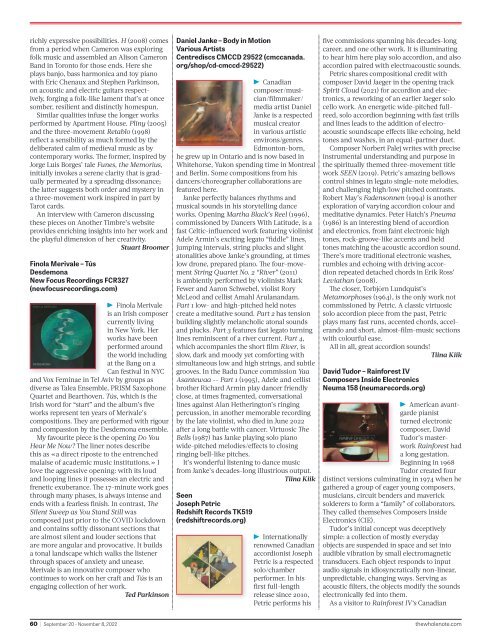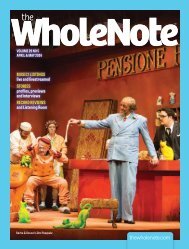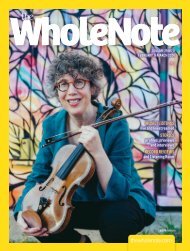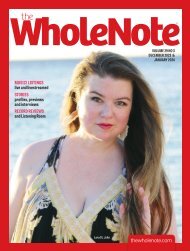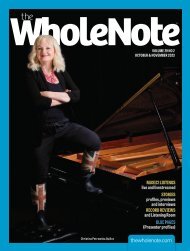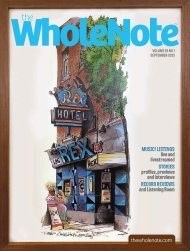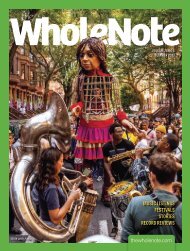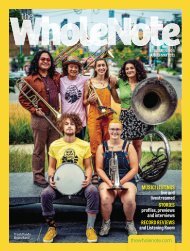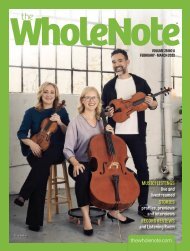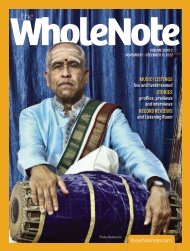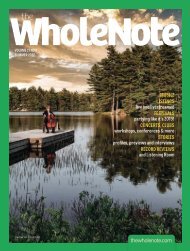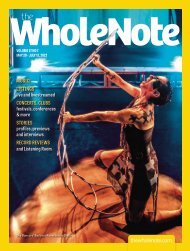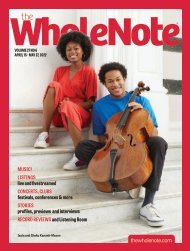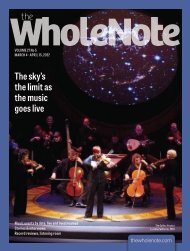Volume 28 Issue 1 | September 20 - November 8, 2022
Our 28th season in print! “And Now, Back to Live Action”; a symphonic-sized listings section, compared to last season; clubs “On the move” ; FuturesStops Festival and Nuit Blanche; “Pianistic high-wire acts”; Season announcements include full-sized choral works like Mendelssohn’s Elijah; “Icons, innovators and renegades” pulling out all the stops.
Our 28th season in print! “And Now, Back to Live Action”; a symphonic-sized listings section, compared to last season; clubs “On the move” ; FuturesStops Festival and Nuit Blanche; “Pianistic high-wire acts”; Season announcements include full-sized choral works like Mendelssohn’s Elijah; “Icons, innovators and renegades” pulling out all the stops.
You also want an ePaper? Increase the reach of your titles
YUMPU automatically turns print PDFs into web optimized ePapers that Google loves.
ichly expressive possibilities. H (<strong>20</strong>08) comes<br />
from a period when Cameron was exploring<br />
folk music and assembled an Alison Cameron<br />
Band in Toronto for those ends. Here she<br />
plays banjo, bass harmonica and toy piano<br />
with Eric Chenaux and Stephen Parkinson,<br />
on acoustic and electric guitars respectively,<br />
forging a folk-like lament that’s at once<br />
somber, resilient and distinctly homespun.<br />
Similar qualities infuse the longer works<br />
performed by Apartment House. Pliny (<strong>20</strong>05)<br />
and the three-movement Retablo (1998)<br />
reflect a sensibility as much formed by the<br />
deliberated calm of medieval music as by<br />
contemporary works. The former, inspired by<br />
Jorge Luis Borges’ tale Funes, the Memorius,<br />
initially invokes a serene clarity that is gradually<br />
permeated by a spreading dissonance;<br />
the latter suggests both order and mystery in<br />
a three-movement work inspired in part by<br />
Tarot cards.<br />
An interview with Cameron discussing<br />
these pieces on Another Timbre’s website<br />
provides enriching insights into her work and<br />
the playful dimension of her creativity.<br />
Stuart Broomer<br />
Finola Merivale – Tús<br />
Desdemona<br />
New Focus Recordings FCR327<br />
(newfocusrecordings.com)<br />
! Finola Merivale<br />
is an Irish composer<br />
currently living<br />
in New York. Her<br />
works have been<br />
performed around<br />
the world including<br />
at the Bang on a<br />
Can festival in NYC<br />
and Vox Feminae in Tel Aviv by groups as<br />
diverse as Talea Ensemble, PRISM Saxophone<br />
Quartet and Bearthoven. Tús, which is the<br />
Irish word for “start” and the album’s five<br />
works represent ten years of Merivale’s<br />
compositions. They are performed with rigour<br />
and compassion by the Desdemona ensemble.<br />
My favourite piece is the opening Do You<br />
Hear Me Now? The liner notes describe<br />
this as «a direct riposte to the entrenched<br />
malaise of academic music institutions.» I<br />
love the aggressive opening: with its loud<br />
and looping lines it possesses an electric and<br />
frenetic exuberance. The 17-minute work goes<br />
through many phases, is always intense and<br />
ends with a fearless finish. In contrast, The<br />
Silent Sweep as You Stand Still was<br />
composed just prior to the COVID lockdown<br />
and contains softly dissonant sections that<br />
are almost silent and louder sections that<br />
are more angular and provocative. It builds<br />
a tonal landscape which walks the listener<br />
through spaces of anxiety and unease.<br />
Merivale is an innovative composer who<br />
continues to work on her craft and Tús is an<br />
engaging collection of her work.<br />
Ted Parkinson<br />
Daniel Janke – Body in Motion<br />
Various Artists<br />
Centrediscs CMCCD 29522 (cmccanada.<br />
org/shop/cd-cmccd-29522)<br />
! Canadian<br />
composer/musician/filmmaker/<br />
media artist Daniel<br />
Janke is a respected<br />
musical creator<br />
in various artistic<br />
environs/genres.<br />
Edmonton-born,<br />
he grew up in Ontario and is now based in<br />
Whitehorse, Yukon spending time in Montreal<br />
and Berlin. Some compositions from his<br />
dancers/choreographer collaborations are<br />
featured here.<br />
Janke perfectly balances rhythms and<br />
musical sounds in his storytelling dance<br />
works. Opening Martha Black’s Reel (1996),<br />
commissioned by Dancers With Latitude, is a<br />
fast Celtic-influenced work featuring violinist<br />
Adele Armin’s exciting legato “fiddle” lines,<br />
jumping intervals, string plucks and slight<br />
atonalities above Janke’s grounding, at times<br />
low drone, prepared piano. The four-movement<br />
String Quartet No. 2 “River” (<strong>20</strong>11)<br />
is ambiently performed by violinists Mark<br />
Fewer and Aaron Schwebel, violist Rory<br />
McLeod and cellist Amahl Arulanandam.<br />
Part 1 low- and high-pitched held notes<br />
create a meditative sound. Part 2 has tension<br />
building slightly melancholic atonal sounds<br />
and plucks. Part 3 features fast legato turning<br />
lines reminiscent of a river current. Part 4,<br />
which accompanies the short film River, is<br />
slow, dark and moody yet comforting with<br />
simultaneous low and high strings, and subtle<br />
grooves. In the Badu Dance commission Yaa<br />
Asantewaa -- Part 1 (1995), Adele and cellist<br />
brother Richard Armin play dancer friendly<br />
close, at times fragmented, conversational<br />
lines against Alan Hetherington’s ringing<br />
percussion, in another memorable recording<br />
by the late violinist, who died in June <strong>20</strong>22<br />
after a long battle with cancer. Virtuosic The<br />
Bells (1987) has Janke playing solo piano<br />
wide-pitched melodies/effects to closing<br />
ringing bell-like pitches.<br />
It’s wonderful listening to dance music<br />
from Janke’s decades-long illustrious output.<br />
Tiina Kiik<br />
Seen<br />
Joseph Petric<br />
Redshift Records TK519<br />
(redshiftrecords.org)<br />
! Internationally<br />
renowned Canadian<br />
accordionist Joseph<br />
Petric is a respected<br />
solo/chamber<br />
performer. In his<br />
first full-length<br />
release since <strong>20</strong>10,<br />
Petric performs his<br />
five commissions spanning his decades-long<br />
career, and one other work. It is illuminating<br />
to hear him here play solo accordion, and also<br />
accordion paired with electroacoustic sounds.<br />
Petric shares compositional credit with<br />
composer David Jaeger in the opening track<br />
Spirit Cloud (<strong>20</strong>21) for accordion and electronics,<br />
a reworking of an earlier Jaeger solo<br />
cello work. An energetic wide-pitched fullreed,<br />
solo accordion beginning with fast trills<br />
and lines leads to the addition of electroacoustic<br />
soundscape effects like echoing, held<br />
tones and washes, in an equal-partner duet.<br />
Composer Norbert Palej writes with precise<br />
instrumental understanding and purpose in<br />
the spiritually themed three-movement title<br />
work SEEN (<strong>20</strong>19). Petric’s amazing bellows<br />
control shines in legato single-note melodies,<br />
and challenging high/low pitched contrasts.<br />
Robert May’s Fadensonnen (1994) is another<br />
exploration of varying accordion colour and<br />
meditative dynamics. Peter Hatch’s Pneuma<br />
(1986) is an interesting blend of accordion<br />
and electronics, from faint electronic high<br />
tones, rock-groove-like accents and held<br />
tones matching the acoustic accordion sound.<br />
There’s more traditional electronic washes,<br />
rumbles and echoing with driving accordion<br />
repeated detached chords in Erik Ross’<br />
Leviathan (<strong>20</strong>08).<br />
The closer, Torbjörn Lundquist’s<br />
Metamorphoses (1964), is the only work not<br />
commissioned by Petric. A classic virtuosic<br />
solo accordion piece from the past, Petric<br />
plays many fast runs, accented chords, accelerando<br />
and short, almost-film-music sections<br />
with colourful ease.<br />
All in all, great accordion sounds!<br />
Tiina Kiik<br />
David Tudor – Rainforest IV<br />
Composers Inside Electronics<br />
Neuma 158 (neumarecords.org)<br />
! American avantgarde<br />
pianist<br />
turned electronic<br />
composer, David<br />
Tudor’s masterwork<br />
Rainforest had<br />
a long gestation.<br />
Beginning in 1968<br />
Tudor created four<br />
distinct versions culminating in 1974 when he<br />
gathered a group of eager young composers,<br />
musicians, circuit benders and maverick<br />
solderers to form a “family” of collaborators.<br />
They called themselves Composers Inside<br />
Electronics (CIE).<br />
Tudor’s initial concept was deceptively<br />
simple: a collection of mostly everyday<br />
objects are suspended in space and set into<br />
audible vibration by small electromagnetic<br />
transducers. Each object responds to input<br />
audio signals in idiosyncratically non-linear,<br />
unpredictable, changing ways. Serving as<br />
acoustic filters, the objects modify the sounds<br />
electronically fed into them.<br />
As a visitor to Rainforest IV‘s Canadian<br />
60 | <strong>September</strong> <strong>20</strong> - <strong>November</strong> 8, <strong>20</strong>22 thewholenote.com


